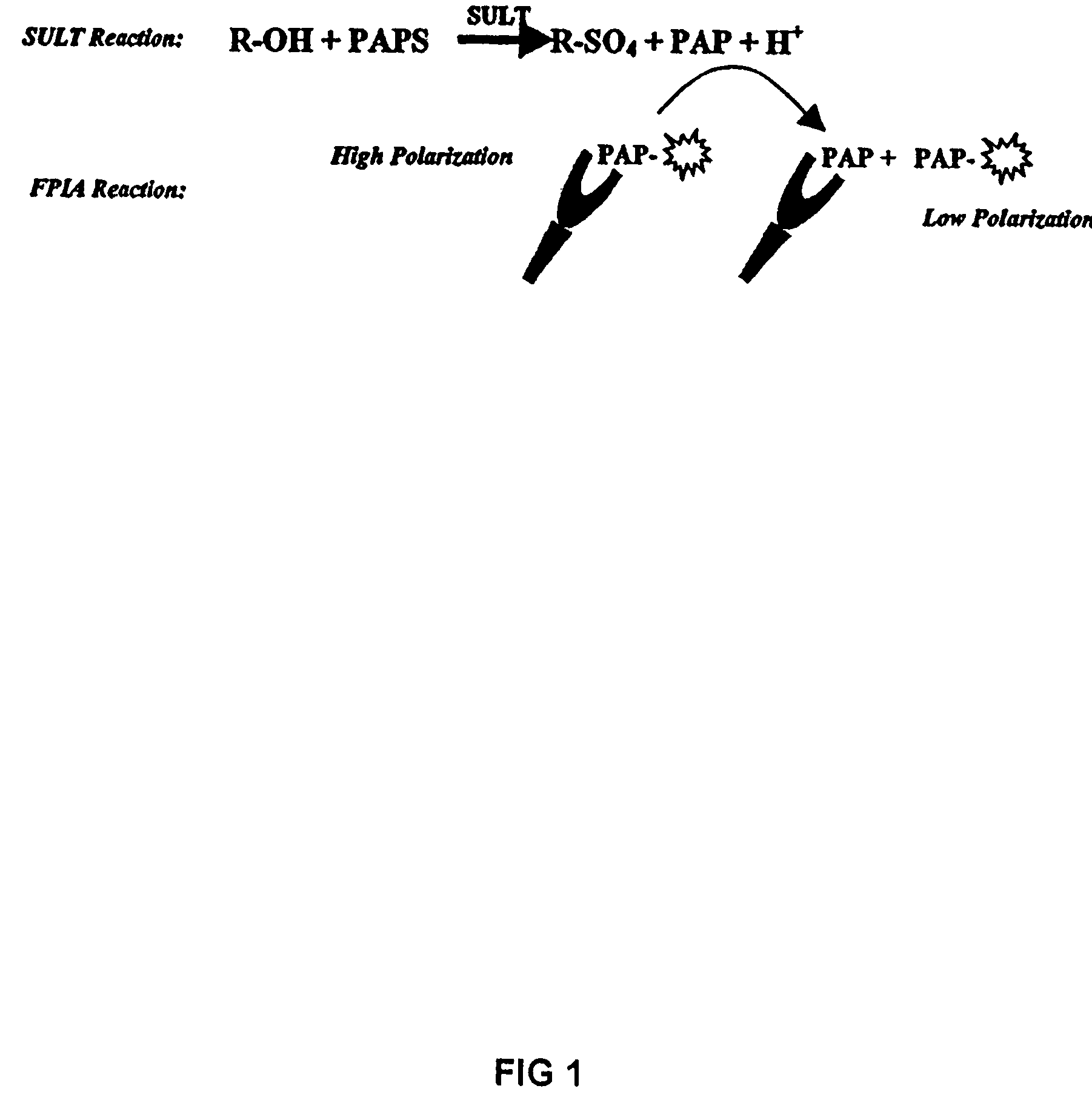Assay method for group transfer reactions
a group transfer and reaction technology, applied in the field of group transfer reaction methodologies, can solve the problems of cumbersome post-reaction separation steps, serious limits on the utility of the assay, and slowed or prevented incorporation of group transfer enzymes into pharmaceutical hts programs
- Summary
- Abstract
- Description
- Claims
- Application Information
AI Technical Summary
Benefits of technology
Problems solved by technology
Method used
Image
Examples
example 1
Uridine Glucuronide Transferase Assay
[0145]One embodiment of this application involves detecting the “donor product” of the UGT reaction using a competitive fluorescence polarization immunoassay where the antibody-bound tracer has a high polarization value which decreases when it is displaced by an analyte, such as UDP (as shown in FIG. 2). The main reagent required for this assay is the production of an antibody that binds UDP with high selectivity and has negligible binding to the donor, UDP-glucuronic acid (UDPGA). This highly selective antibody is used in combination with fluorescent UTP compounds (as substitutes for UDP tracers) to establish the assay. The polyclonal antibody produced against UDP required covalent binding of the nucleotide hapten to a carrier protein. UTP was used as the hapten only because reactive derivatives of the triphosphate, but not the diphosphate, were readily available that could be used for conjugation. It was reasoned that the majority of the tripho...
example 2
Assays for Other Types of Glycosyltransferases
[0156]Glucuronic acid is one type of carbohydrate molecule that is activated by UDP for enzymatic transfer to other biomolecules; there are many other types of group transfer reactions that use UDP-sugar as an activated donor. These include protein glycosyltransferases that modulate the cellular localization and / or secretion of proteins via their carbohydrate modifications and biosynthetic enzymes that incorporate sugar monomers into polymers such as glycogen and bacterial peptidoglycan. Many of these enzymes are potential targets for therapeutic intervention, both in humans or for antimicrobials.
[0157]One class of microbial glycosyltransferases that are of interest from a drug discovery perspective include transferases involved in bacterial cell wall synthesis such as the UDP-galactofurnosyltransferase of Mycobacterium tuberculosis (Cren, S., Gurcha, S. S., Blake, A. J., Besra, G. S., Thomas, N. R. Org. Biomol. Chem. 2; 2418-2420. A mam...
example 3
Kinase Assays
[0158]To develop an anti-ADP antibody, 6-aminobutyl-ADP (Biolog Life Science Inst., Bremen, Germany) was conjugated to keyhole limpet hemocyanin with a suitable reagent such as glutaraldehyde and used to immunize rabbits. Other carrier proteins such as BSA or ovalbumin and other conjugation chemistries may be used. Attachment to carrier protein via the adenine ring exposes the ribosyl-phosphate moiety, where selectivity is required, and minimizes exposure of the adenine ring. The resulting antisera was tested for ADP binding affinity and selectivity in competitive fluorescence polarization binding assays. Synthesis of the fluor-ADP conjugates used as tracers in these binding assays is described below. Crude serum from naïve rabbits can exhibit high background binding to ADP tracers, so the antiserum was purified using immobilized Protein G (Pierce, Rockford, Illinos) to isolate the IgG fraction. To show that ADP displaced tracer from the purified ADP polyclonal antibody...
PUM
| Property | Measurement | Unit |
|---|---|---|
| time period | aaaaa | aaaaa |
| volumes | aaaaa | aaaaa |
| pH | aaaaa | aaaaa |
Abstract
Description
Claims
Application Information
 Login to View More
Login to View More - R&D
- Intellectual Property
- Life Sciences
- Materials
- Tech Scout
- Unparalleled Data Quality
- Higher Quality Content
- 60% Fewer Hallucinations
Browse by: Latest US Patents, China's latest patents, Technical Efficacy Thesaurus, Application Domain, Technology Topic, Popular Technical Reports.
© 2025 PatSnap. All rights reserved.Legal|Privacy policy|Modern Slavery Act Transparency Statement|Sitemap|About US| Contact US: help@patsnap.com



